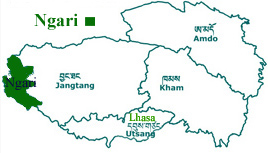Destination: Tibet >Ngari
Information
 The region of Far-west Tibet (Ngari), and the neighboring Jangtang plateau, are the least populated parts of the country. Mount Kailash, renowned for its spiritual magnetism and natural beauty, is the sacred focal point for pilgrims and hardy travellers. Concealed within the deeply eroded sandstone canyons of the upper Sutlej basin are numerous ruins of ancient troglodyte cities: Toling, Tsaparang, Dungkar, Piyang and Manam, that once comprised the medieval kingdom of Gu-ge. A number of temples are still intact, containing exquisite murals and decorative motifs, some dating back more than 1,000 years.
The region of Far-west Tibet (Ngari), and the neighboring Jangtang plateau, are the least populated parts of the country. Mount Kailash, renowned for its spiritual magnetism and natural beauty, is the sacred focal point for pilgrims and hardy travellers. Concealed within the deeply eroded sandstone canyons of the upper Sutlej basin are numerous ruins of ancient troglodyte cities: Toling, Tsaparang, Dungkar, Piyang and Manam, that once comprised the medieval kingdom of Gu-ge. A number of temples are still intact, containing exquisite murals and decorative motifs, some dating back more than 1,000 years.
Access
Ngari Gunsa Airport, near the prefectural capital of Senge Khabab, opened to the public in 2010. There are twice weekly flights between Gongkar and Ngari Gunsa airports—weather permitting. Otherwise, access to this vast region is only possible through long overland drives from Lhasa, Nepal or Xinjiang (H219), or by helicopter from Nepalganj in Western Nepal. The Hindustan Highway from India which leads directly to Gu-ge is currently closed, pending resolution of a long-standing border dispute.
Culture
The northern plateau of Tibet, known as the Jangtang, is a vast lakeland wilderness, over 438,000 sq km in area (average elevation: 4,500m), and demarcated by the Kunlun Mountains to the north, the Gangtise and Nyenchen Tanglha ranges to the south, the basin of the upper Indus to the west, and those of the upper Salween and Yangtze to the east and northeast. The Jangtang is dotted with brackish salt lakes, the largest among them being Namtso, Serling, Dangra Yutso, Ngangla Ringmo, and Pang-gang. In antiquity the Jangtang was an important region for the pre-Buddhist civilization of Zhangzhung. Since 1993, its northernmost parts have formed the world's second largest nature reserve (300,000 square kilometres), exceeded only by the ice-caps of the Greenland National Park. This is the natural habitat of the wild yak, kyang, blue sheep, argali, gazelle and antelope, and predators, such as the wolf, lynx, brown bear, and the endangered snow leopard.
